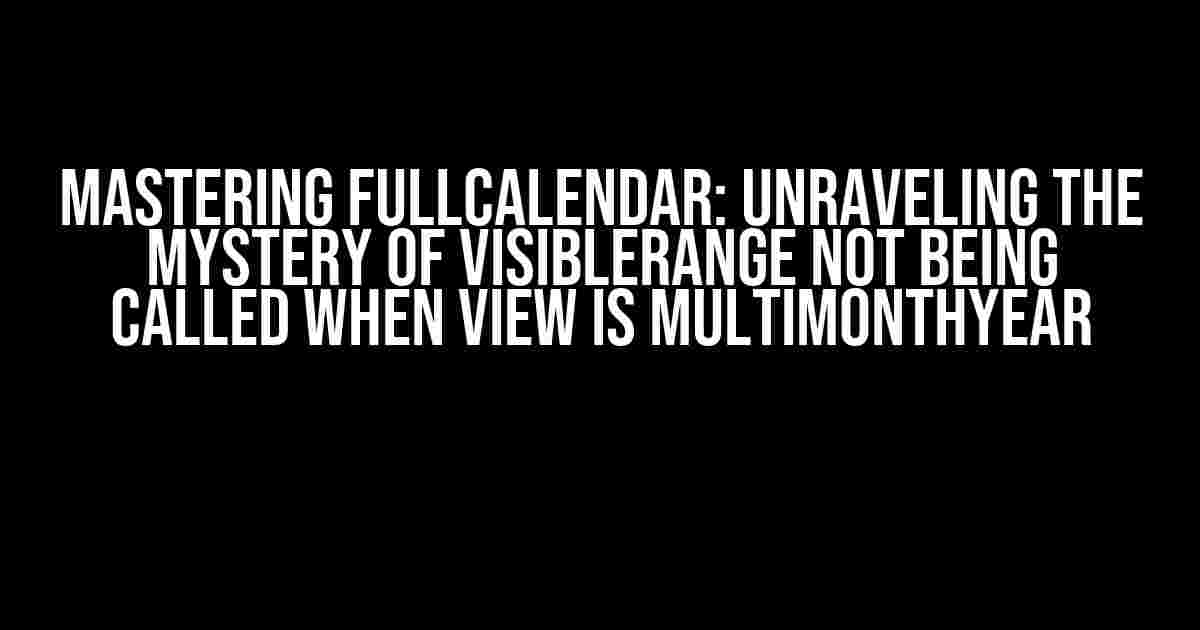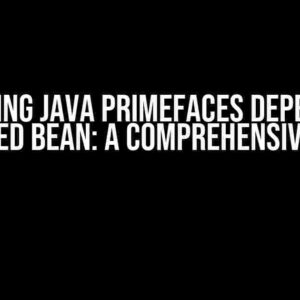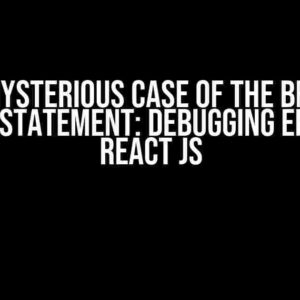Are you struggling with Fullcalendar’s visibleRange not being called when the view is set to multiMonthYear? Don’t worry, you’re not alone! This pesky issue has been driving developers crazy, but fear not, dear reader, for we’re about to dive into the solution together.
Understanding the Problem
The visibleRange callback is a crucial event in Fullcalendar that allows you to execute custom code when the user navigates through the calendar. However, when the view is set to multiMonthYear, this callback seems to vanish into thin air, leaving you scratching your head.
var calendar = $('#calendar').fullCalendar({
view: 'multiMonthYear',
visibleRange: function(date) {
console.log('visibleRange callback not being called :(');
}
});
The Reason Behind the Issue
The root of the problem lies in the way Fullcalendar handles the multiMonthYear view. When this view is enabled, Fullcalendar renderes multiple months side-by-side, creating a unique rendering scenario that bypasses the visibleRange callback.
Solving the Mystery
So, how do we get our beloved visibleRange callback to work its magic again? There are a couple of approaches to tackle this issue. Buckle up, because we’re about to dive into the solutions!
Approach 1: Utilizing the viewRender Event
The viewRender event is triggered whenever the calendar is rendered or re-rendered. By leveraging this event, we can manually call the visibleRange callback and get our desired outcome.
var calendar = $('#calendar').fullCalendar({
view: 'multiMonthYear',
viewRender: function(view) {
var visibleRange = calendar.fullCalendar('getVisibleRange');
console.log('visibleRange callback manually called:', visibleRange);
}
});
Approach 2: Overriding the view class
This approach requires a bit more hackery, but it’s worth it for those seeking a more elegant solution. We’ll create a custom view class that inherits from the original MultiMonthYearView and overrides its renderRange method.
var CustomMultiMonthYearView = FC.MultiMonthYearView.extend({
renderRange: function(date) {
FC.MultiMonthYearView.prototype.renderRange.apply(this, arguments);
this.trigger('visibleRange', [date]);
}
});
var calendar = $('#calendar').fullCalendar({
view: 'customMultiMonthYear',
views: {
customMultiMonthYear: CustomMultiMonthYearView
},
visibleRange: function(date) {
console.log('visibleRange callback called:', date);
}
});
Common Pitfalls and Troubleshooting
While solving the visibleRange issue, you might encounter some additional hurdles. Let’s address some common pitfalls and provide solutions to get you back on track.
Pitfall 1: visibleRange Not Being Called on Initial Render
- If you’re using the viewRender approach, ensure you’ve initialized the calendar before calling the visibleRange callback. You can do this by adding a slight delay using setTimeout or by checking if the calendar is fully rendered.
var calendar = $('#calendar').fullCalendar({
view: 'multiMonthYear',
viewRender: function(view) {
setTimeout(function() {
var visibleRange = calendar.fullCalendar('getVisibleRange');
console.log('visibleRange callback manually called:', visibleRange);
}, 100);
}
});
Pitfall 2: visibleRange Being Called Multiple Times
- If you’re using the custom view class approach, make sure to remove the original visibleRange callback to avoid duplicate calls.
var calendar = $('#calendar').fullCalendar({
view: 'customMultiMonthYear',
views: {
customMultiMonthYear: CustomMultiMonthYearView
}
});
// Remove original visibleRange callback
calendar.fullCalendar('removeEventListener', 'visibleRange');
Conclusion
Voilà! We’ve conquered the enigmatic issue of Fullcalendar’s visibleRange not being called when the view is set to multiMonthYear. By applying either of the two approaches, you’ll be able to harness the power of the visibleRange callback and take your calendar applications to the next level.
Remember, mastery of Fullcalendar requires patience, persistence, and a willingness to dive into the depths of its intricacies. With this article, you’ve taken a significant step forward in taming the beast that is Fullcalendar.
| Solution | Description | Code Snippet |
|---|---|---|
| Approach 1: viewRender Event | Manually call visibleRange callback on viewRender event | viewRender: function(view) { ... } |
| Approach 2: Custom View Class | Override MultiMonthYearView’s renderRange method to trigger visibleRange callback | CustomMultiMonthYearView = FC.MultiMonthYearView.extend({ ... }) |
Now, go forth and conquer the world of Fullcalendar!
Frequently Asked Question
Got stuck with Fullcalendar? Let’s clear the air!
Why is the visibleRange event not triggered when the view is set to multiMonth or multiYear?
By design, the visibleRange event is only triggered when the view is set to day, week, or month. This is because the concept of a “visible range” isn’t as relevant when displaying multiple months or years at once. However, you can use the viewRender event to achieve similar functionality.
Is there a workaround to get the visibleRange event to work with multiMonth or multiYear views?
One possible solution is to use the viewRender event and calculate the visible range manually. You can use the getView() method to get the current view and then calculate the visible range based on the view’s start and end dates.
What is the purpose of the visibleRange event in Fullcalendar?
The visibleRange event is triggered when the user navigates to a new date range in the calendar. It provides the start and end dates of the new visible range, allowing you to perform custom actions or updates based on the new range.
Can I use the visibleRange event to load events dynamically from my server?
Yes, that’s a great use case for the visibleRange event! You can use the event to send an AJAX request to your server to fetch events for the new visible range, and then add them to the calendar using the addEvent method.
Are there any alternative libraries or plugins that support visibleRange events for multiMonth or multiYear views?
While Fullcalendar doesn’t support visibleRange events for multiMonth or multiYear views out of the box, there are other libraries and plugins that might offer similar functionality. For example, you could explore alternatives like DHTMLX Scheduler or DayPilot, which might provide the features you need.



